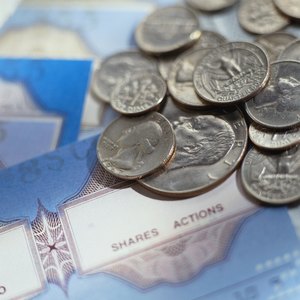
If you own shares in a publicly traded company, the chances are good that you are familiar with dividend payment. When a public company generates cash through their business operations, they typically allocate a portion of this revenue to their shareholders via dividend payments. When dividends are paid to shareholders, this cash transfer is often reported as an outflow on the company's cash flow statement. Using a simple formula, you can determine what proportion of outward cash flow is devoted to dividend payments.
Tips
A cash flow statement allows individuals to better asses the extent to which dividends are being paid to shareholders and what percentage of outward cash flow is represented by these dividends.
Understanding The Fundamentals
It is important to remember that not all outbound cash flow is devoted to dividend payments. In fact, the dividends appearing as part of the outward cash flow typically represent payments made to holders of common stock, or stock that offers dividends on a discretionary basis to shareholders. Unlike preferred stocks, which offer consistent dividend payments, it is quite possible that dividends may not be paid at all to holders of common stock. However, given the fact that common stock shareholders have ownership of the company proportional to the number of shares they hold, these individuals are also able to influence the direction and decisions of the company's board of directors to a certain extent.
Likewise, interest paid on loans and bonds will also appear as cash outflow, making it that much more important for investors to understand how to properly read and assess the information available on cash flow statements.
Calculating Cash Flow and Dividends
In order to determine the proportion of outflow devoted to common stock dividend payments, you will first need to know the current dividend payments and the number of shares to which dividends are being paid. So, if there is a $2 quarterly dividend on 2,000,000 outstanding shares, we would know that there is $4,000,000 outflow in dividend payments per quarter. This information can be particularly helpful when you are weighing the risks and benefits of purchasing shares in a company.
If, for example, a company is reaping significant stock market gains but devotes little outflow to common stockholders, it may not be worth your time to invest. However, if you notice significant cash outflow to stockholders in lean economic times, this may appear to be a seemingly unstable decision that would also cause you to think twice before investing. With this information in mind, it is easy to understand why a cash flow statement can act as an excellent prognosticator of a company's current values and future success. With that in mind, it strongly recommend that you take the time to review cash flow statements regularly as part of your evaluative research into companies who you may be interested in investing in.
References
- AccountingCoach: Cash Flow Statement
- Cash Flow Statement: Explanation and Example | Bench Accounting
- U.S. Securities and Exchange Commission. "Dividend." Accessed June 17, 2020.
- Fidelity Investments. "What Are Dividends?" Accessed June 17, 2020.
- Corporate Finance Institute. "Important Dividend Dates." Accessed June 17, 2020.
- Corporate Finance Institute. "Dividend." Accessed June 17, 2020.
- Fidelity Investments. "Preferred Stock." Accessed June 17, 2020.
- Rice University. "Record Transactions and the Effects on Financial Statements for Cash Dividends, Property Dividends, Stock Dividends, and Stock Splits." Accessed June 17, 2020.
- Corporate Finance Institute. "Special Dividend." Accessed June 17, 2020.
- Pennsylvania Department of Revenue. "Dividends." Accessed June 17, 2020.
- Corporate Finance Institute. "Dividend Payout Ratio." Accessed June 17, 2020.
- U.S. Securities and Exchange Commission. "Form 10-K Coca Cola Co." Accessed June 17, 2020.
- Charles Schwab & Co. "Dividend Yield and Dividend Growth: Fundamental Value Analytics." Accessed June 17, 2020.
- Internal Revenue Service. "Publication 550 (2019): Investment Income and Expenses (Including Capital Gains and Losses)," Page 19. Accessed June 17, 2020.
- Value Line. "Dividends Come Out of Cash Flow, Not Earnings." Accessed June 17, 2020.
- Pillsbury Law. "SEC Disclosure Update and Simplification." Accessed June 17, 2020.
- Corporate Finance Institute. "Dividend Reinvestment Plan (DRIP)." Accessed June 17, 2020.
- Robinhood. "What Is a Dividend Reinvestment Plan (DRIP)?" Accessed June 17, 2020.
- U.S. Securities and Exchange Commission. "American Financial Group Inc. - Dividend Reinvestment Plan." Accessed June 17, 2020.
Writer Bio
Ryan Cockerham is a nationally recognized author specializing in all things innovation, business and creativity. His work has served the business, nonprofit and political community. Ryan's work has been featured at Zacks Investment Research, SFGate Home Guides, Bloomberg, HuffPost and more.

